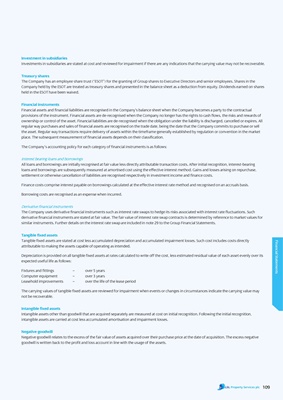
investment in subsidiaries
Investments in subsidiaries are stated at cost and reviewed for impairment if there are any indications that the carrying value may not be recoverable.
treasury shares
The Company has an employee share trust (“ESOT”) for the granting of Group shares to Executive Directors and senior employees. Shares in the
Company held by the ESOT are treated as treasury shares and presented in the balance sheet as a deduction from equity. Dividends earned on shares
held in the ESOT have been waived.
Financial instruments
Financial assets and financial liabilities are recognised in the Company’s balance sheet when the Company becomes a party to the contractual
provisions of the instrument. Financial assets are de-recognised when the Company no longer has the rights to cash flows, the risks and rewards of
ownership or control of the asset. Financial liabilities are de-recognised when the obligation under the liability is discharged, cancelled or expires. All
regular way purchases and sales of financial assets are recognised on the trade date, being the date that the Company commits to purchase or sell
the asset. Regular way transactions require delivery of assets within the timeframe generally established by regulation or convention in the market
place. The subsequent measurement of financial assets depends on their classification.
The Company’s accounting policy for each category of financial instruments is as follows:
Interest bearing loans and borrowings
All loans and borrowings are initially recognised at fair value less directly attributable transaction costs. After initial recognition, interest-bearing
loans and borrowings are subsequently measured at amortised cost using the effective interest method. Gains and losses arising on repurchase,
settlement or otherwise cancellation of liabilities are recognised respectively in investment income and finance costs.
Finance costs comprise interest payable on borrowings calculated at the effective interest rate method and recognised on an accruals basis.
Borrowing costs are recognised as an expense when incurred.
Derivative financial instruments
The Company uses derivative financial instruments such as interest rate swaps to hedge its risks associated with interest rate fluctuations. Such
derivative financial instruments are stated at fair value. The fair value of interest rate swap contracts is determined by reference to market values for
similar instruments. Further details on the interest rate swap are included in note 29 to the Group Financial Statements.
tangible fixed assets
Tangible fixed assets are stated at cost less accumulated depreciation and accumulated impairment losses. Such cost includes costs directly
Financial Statements
attributable to making the assets capable of operating as intended.
Depreciation is provided on all tangible fixed assets at rates calculated to write off the cost, less estimated residual value of each asset evenly over its
expected useful life as follows:
Fixtures and fittings – over 5 years
Computer equipment – over 3 years
Leasehold improvements – over the life of the lease period
The carrying values of tangible fixed assets are reviewed for impairment when events or changes in circumstances indicate the carrying value may
not be recoverable.
intangible fixed assets
Intangible assets other than goodwill that are acquired separately are measured at cost on initial recognition. Following the initial recognition,
intangible assets are carried at cost less accumulated amortisation and impairment losses.
negative goodwill
Negative goodwill relates to the excess of the fair value of assets acquired over their purchase price at the date of acquisition. The excess negative
goodwill is written back to the profit and loss account in line with the usage of the assets.
109